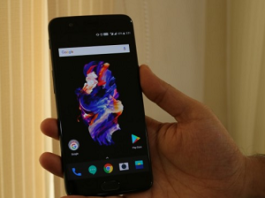
OnePlus started its journey back in 2014 and in just three years the company is eyeing for the crown. The company’s consumer-first strategy has worked wonders for the brand, but will it go on?
Challenging the tech giants Apple and Samsung, OnePlus launched its 2017 flagship OnePlus 5 in India and around the world in June. Following mixed reviews from consumers and critics, OnePlus 5 laid a firm base on which the company will continue its disruptive journey ahead. The smartphone was also the best selling smartphone during the Amazon Prime Day sale in India last month, and that level of recognition doesn’t come without a reason.
While we watched the OnePlus 5’s success ever since it landed in the market, we stayed committed to pushing the handset to the limits. International Business Times, India, inspected the bundle of features that OnePlus so-proudly showed-off at the launch event during a four-week period.
OnePlus 5 had its stream of “WOW” moments along with some “Oh snap” cries. In this review, we are going to show both sides of the phone that will determine its worth to many potential buyers.
Wow-factors
To begin with, OnePlus 5 packs more than one great specs to make it an absolute beast. What we truly loved about this phone is its capability to perform at its best no matter what. Of course, we have the Snapdragon 835 chipset paired with 8GB RAM to thank for, but the optimization of the software to carry out the most difficult tasks with ease is impressive.
Other features that will woo its users include the super-fast fingerprint scanner with 100 percent accuracy, low-light portraits, snappy UI, and a reliable battery with Dash Charge 3 charger.
Amiss
Details matter. Overall the OnePlus 5 doesn’t seize to impress. But if we look closely, the phone gives a miss on certain occasions. For instance, the camera is great on its own. The dual camera setup at the back helps with portraits and the primary lens truly justifies low-light imaging and macro shots. However, the framing remains a concern while shooting landscapes and videos as the lens is not as wide as other phones (iPhone 7 Plus for instance). This forces users to adjust the framing by panning out, which may not be practical under all circumstances.
Besides the camera, we find the design to be traditional. While a lot of people criticised the OnePlus 5, saying it looks like an iPhone 7 Plus, we did not find any reason to look down on that. There may be a few similarities, the rear camera portion to be precise, but OnePlus has added its unique touches in every nook and corner of the phone.
Design
Carefully designed to cater to the majority, OnePlus 5 is one of the most practical phones in terms of usability. It’s compact, but not too small, stylish but not too loud and keeps the minimalistic quotient in check.
The aluminium unibody shell gives OnePlus 5 the armour it needs to stand against the rivals, but we found the casing to be light and thin. That’s not a bad thing at all, as it helped the maker keep the phone sleek at 7.25mm and light at 153g, which adds to the practical use-case.
The “do not disturb” slider with three modes is unique to OnePlus 5 and the single speaker grille at the bottom makes sound loud enough to be audible in a noisy room. At the bottom, we also find the USB Type-C port and the physical home button below the display hasn’t disappeared and still houses the fingerprint scanner.
Display
In all fairness, we were disappointed when the OnePlus 5 was launched with a Full HD resolution screen measuring 5.5 inches. While most found it to be a letdown for a smartphone claiming to be a “flagship killer,” it makes sense in the real world.
The phone’s display has various customisation options to fit the needs of users at different times. The most basic is the adaptive brightness, which adjusts according to the surrounding light and the sensors work efficiently. There’s also night and reading mode, which work one at a time.
The night mode is great for watching movies, playing games, using social media in dim-lit areas to reduce strain on the eyes. The reading mode is quite unique, which lets you add apps that automatically switch to paper-like look when launched. For instance, we had the Kindle app set for reading mode by default and it launches the app in black and white without us having to do it every time. You can also add news apps and more similar apps which involve a lot of reading and save battery as well as strain on eyes.
While many users might ignore this, but the screen calibration has options that will push your Full HD screen to its limits. The default setting is ideal, but there’s also sRGB and DCI-P3 colour profiles to add the extra punch of colours to the images. For using under brighter conditions, the DCI-P3 comes in handy, while the sRGB gives you a faded taste if that’s what you prefer.
OnePlus clearly did not invest much into the display, but the next category certainly did attract a lot of company’s attention.
Camera
We know where all the money went. OnePlus 5’s camera got the company’s undivided attention. The dual camera on the rear, manufactured in collaboration with DxO Labs, combines a 16MP f/1.7 primary sensor with a 20MP f/.26 telephoto lens to produce detailed images. At least, that’s what the spec-sheet tells us.
So we took OnePlus 5 for a test run and we must say the phone surprised us on many occasions. The most impressive part of the OnePlus 5’s camera is the phone’s capability to shoot detailed macro images, even in challenging light conditions. We had a bit of an issue with focusing in low lights, but the Pro Mode comes in handy.
The Portrait mode, which uses both lenses, creates a Bokeh-effect, which we appreciated until compared with iPhone 7 Plus. Unlike the Apple’s flagship, the OnePlus 5 allows portrait shots even in dim-lit conditions when the iPhone 7 Plus simply asks to try with better lighting.
Another disappointment in the camera is the loss of detail and true colours in low-lighting conditions. We also noticed ghosting effect in many photos shot during the day. But the 1X, 2X default zoom options can help you get lossless images even when you zoom. This is a great feature when you are not closer to the subject and unable to identify how much you can zoom to keep the pixels intact.
OnePlus 5’s primary lens doesn’t capture the subject entirely like the iPhone 7 Plus from the same distance. The lens is not as wide as its rivals, which makes it difficult to get the desired framing without panning.
Despite the shortcomings, OnePlus 5 makes a winning argument with night shots. You can capture the beautiful landscapes of the city with default mode and elevate the results with Pro Mode. If your photos find home in social media, OnePlus 5 isn’t a disappointment at all.
We have to side with the iPhone 7 Plus in terms of better photo results. However, videos produced using OnePlus 5 in 720p, Full HD and 2K resolution are up to the mark. The audio is captured in its true form to add value to your video, be it an interview or a concert.
Shifting the focus to the front camera, selfie lovers will find some photos oversaturated under bright lights. In low-lights, the OnePlus 5 camera with its screen flash can save the day. End of the day, your selfies shot on OnePlus 5 will get you equal number of “hearts” on Instagram and “likes” on Facebook.
Recent Random Post:















